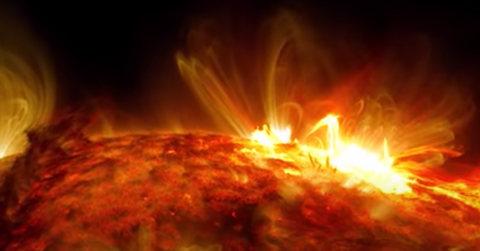NASA "Touched" the Sun for the First Time — Here’s What That Means
Published Dec. 15 2021, 12:05 p.m. ET
Icarus would definitively say that flying too close to the sun is a bad thing; however, it looks like NASA has officially proven him wrong.
During an American Geophysical Union meeting on Tuesday, Dec. 14, scientists announced that one of its space crafts descended through the sun's corona in a space mission months earlier. And although data took several months to process, it was evidently successful. This marks the very first time that NASA has touched the sun.
"Parker Solar Probe 'touching the sun' is a monumental moment for solar science and a truly remarkable feat," the associate administrator for NASA's Science Mission Directorate, Thomas Zurbuchen, stated. "Not only does this milestone provide us with deeper insights into our sun's evolution and its impacts on our solar system, but everything we learn about our own star also teaches us more about stars in the rest of the universe.”
Here's what you should know about NASA's Parker Solar Probe "touching the sun:"
Earlier this year, NASA’s Parker Solar Probe was the very first of its kind to travel through the sun's outer atmosphere, amid an excursion to collect magnetic particles for further testing, according to Breezy Scroll. This was the spacecraft's seventh close encounter with the sun, but its closest by far. Since the corona is not a solid surface, it was able to dip in and out at least three times, allowing scientists to investigate solar winds, which take a massive toll on life on Earth.
“The first and most dramatic time we were below for about five hours … Now you might think five hours, that doesn’t sound big,” University of Michigan’s Justin Kasper explained, as per Breezy Scroll. He said it covered approximately 62 miles per second — so Parker certainly got quite a bit of work done in those five hours.
In addition to taking samples, scientists had wanted to see where solar winds form — and the answer has now been uncovered, thanks to this excursion. It's been found that solar winds originate right on the surface of the sun.
“Flying so close to the sun, Parker Solar Probe now senses conditions in the magnetically dominated layer of the solar atmosphere – the corona – that we never could before,” John's Hopkins physicist Nour Raouafi stated, per NASA. “We see evidence of being in the corona in magnetic field data, solar wind data, and visually in images. We can actually see the spacecraft flying through coronal structures that can be observed during a total solar eclipse.”
Watch the video for more on this journey.
The probe's journey to the sun isn't over.
This wasn't the first time Parker had attempted to touch the sun, and luckily for space enthusiasts and scientists alike, it won't be the last.
According to The Wall Street Journal, the accomplished probe is equipped with a camera, probe, tools to measure the corona's electromagnetic fields, and a protective heat shield. It's going to take upwards of 14 more trips to the sun and cover 3.8 million more miles before it's officially retired in 2025.
UC Berkeley astrophysicist, Stuart Bale, told WSJ he's expecting quite a bit of incoming information on the sun, that will hopefully answer more questions for scientists in the foreseeable future.
Needless to say, Parker has a busy and incredibly heated schedule ahead.
